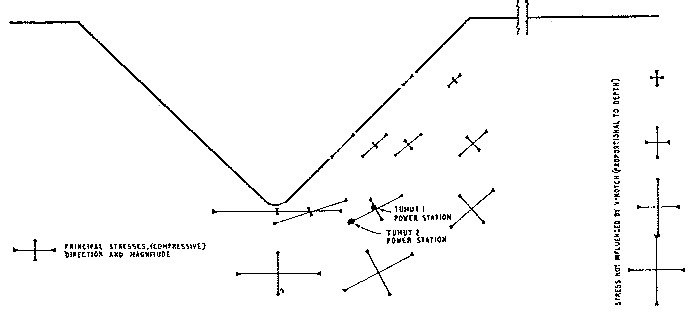Discussion at Technical Session No. 9—Rock Mechanics
He concluded by saying that he believed that horizontal stresses whether in soil masses, sand masses or rock masses could be produced by the relative vertical movements of different parts of the mass, the horizontal stress values being limited only by the shear characteristics of the material. He considered that this concept gave a plausible explanation of faulting. Where materials were brittle and there was a high packing order there was a brittle fault. Where materials were plastic or there was a lower packing order there were plastic deformations or folding.
Mr. G. Worotnicki:
Mr. Worotnicki, in a written contribution commenting on Mr. Moye’s paper, stated that both the Tumut 1 and Tumut 2 power stations were situated near the bottom of the Tumut Valley which was a V—shaped notch in the mountain plateau, about 2,000 ft. deep.
Photo-elastic tests had been carried out on gelatin and plastic models, representing idealised cross-sections of the valley loaded either by gravity or by distributed horizontal forces, or by both simultaneously.

Fig. 9a.—90° V-Notch in a Gelatin Model
Side pressure approximately equal to 0.8 × vertical stress
due to gravity.
The manner in which the topography of the surface may affect the stress pattern in the area of the stations was illustrated in Fig. 9a, which referred to gelatin model with a 90° notch; the horizontal pressure at the model edges nearly equalled the vertical stress due to gravity.
It was shown that in this case the principal stresses at the location of Tumut 1 station were inclined at 30° and 120° to the horizontal; that the horizontal rock pressure was about twice as high as at the points located at the same depth below surface but away from the notch ; and that the vertical pressure was slightly greater than the nominal value corresponding to the vertical distance to the surface.
The photo-elastic tests agreed with the later stress and strain measurements in Tumut l and Tumut 2 power stations in so far as the measurements showed the existence at the sites of the stations of horizontal and vertical pressures each greater than the nominal weight of the rock up to ground surface, and indicated that in both stations the principal rock stresses deviate from the vertical/horizontal directions in the manner predicted.
It was apparent from these tests that the effect of topography in similar cases was sufficiently important to deserve attention of the geologist and the designing engineer.
Mr. Worotnicki stated that some of the results of the earlier rock stress measurements also appear to be related to the topographic effects, e.g., at Boulder Canyon, U.S.A.,(1) high vertical stresses were recorded in the floor ofthe canyon, as under the bottom of the notch in Fig. 9a and at Mont Pezat, France,(2) rock stresses along an inclined subsurface pressure tunnel were directed approximately normal/parallel to the mountain slope as in Fig. 9a.
Referring to Mr. Alexander’s paper, Mr. Worotnicki stated that further confirmation that the rock around Tumut 1 and Tumut 2 machine halls behaved as a quasi-elastic material was provided by the deformation of the roofs of these halls which occurred during excavation of the lower parts of the walls.
